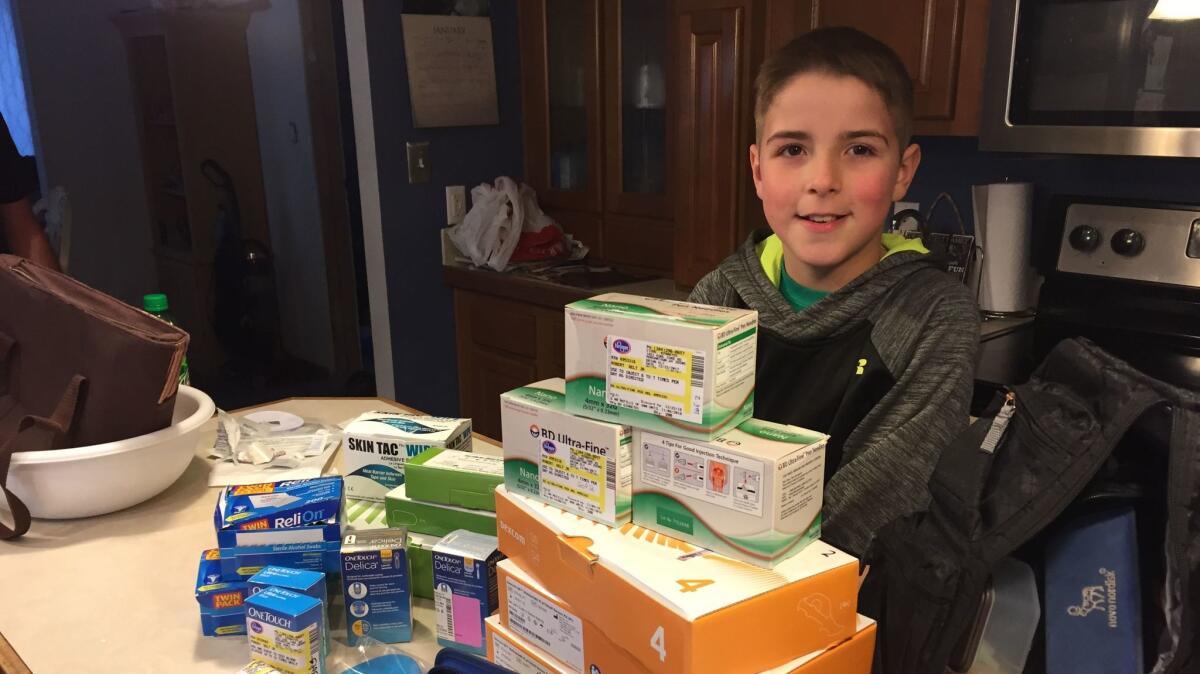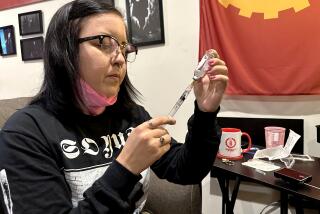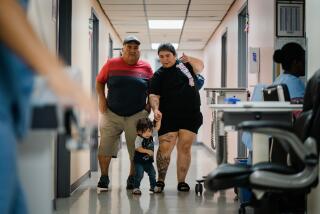Parents agonize over their kids’ health as funding for children’s insurance program remains in doubt

Reporting from Morgantown, W.V. — It was an anxious Christmas and New Year’s for the Belt family.
Tracy and B.J. Belt for years have lived paycheck to paycheck, as B.J.’s truck-driving job at a quarry in the hills around Morgantown hasn’t left much for luxuries.
But this holiday season, the Belts had a new worry. Their two boys, Bobby and Dylan, may soon be uninsured, leaving 11-year-old Bobby without the costly medicine and blood monitors he needs to control his Type 1 diabetes.
“I try to keep Bobby’s mind off of it,” said Tracy Belt, who’s spent the last month scrambling to stockpile prescriptions and medical supplies and frantically scanning Facebook message boards for tips on getting discounted stocks. “But it keeps us up at night…. If Bobby doesn’t have this medication, he will die. It’s as simple as that.”
Like roughly 9 million children nationwide, Bobby and Dylan are covered by the Children’s Health Insurance Program, or CHIP, a government health plan created in 1997 for kids of working families. What keeps their parents up at night are warnings the program may be suspended because Congress has failed since Sept. 30 to pass a measure to reauthorize it.
And although lawmakers passed a stopgap before Christmas, West Virginia is among several states that have warned parents the program could close soon, in its case, at the end of next month.
In Washington, the short-term CHIP funding has been largely written off as a footnote in broader political fights consuming the capital. But for the Belts and legions of other working-class parents around the country, the uncertainty has been agonizing.
“People have no idea what these families are going through,” said Dr. Todd Wolynn, a Pittsburgh pediatrician whose practice cares for hundreds of children covered by CHIP.
“It’s easy to say, ‘There is short-term funding and there’s nothing to worry about.’ But for most of these families, there is no backup plan,” he continued. “Imagine ... if someone said we may have to take your house or your car next month. Except in this case, families are being told they may not be able to protect their children.”
In many states, health officials say they are being inundated with calls from panicked parents trying to figure out what to do. “Our phones are ringing off the walls,” Cathy Caldwell, Alabama’s CHIP director, said last month.
It wasn’t supposed to be this way.
Created through a bipartisan compromise, the popular program has helped drive a historic decline in the share of American children without health insurance, which fell to 4.5% in 2016, down from nearly 14% two decades ago. Lawmakers in both parties say they support the program, but have been deadlocked over how to pay for continuing it.
In poor states such as West Virginia — where many jobs, like B.J. Belt’s, don’t offer health benefits — CHIP offers a crucial safety net. For the Belts, it has been a lifeline especially since Bobby was diagnosed with Type 1 diabetes three years ago.
Type 1 diabetes — which is distinct from the more common Type 2 form of the disease that is linked to diet and weight — is an autoimmune disease usually diagnosed in children and unconnected to lifestyle.
Managing Type 1 diabetes requires regular insulin shots, frequent medical care and careful blood sugar monitoring, which is especially important in active children whose blood sugar can rise and fall dangerously.
Helping Bobby manage his blood sugar became a nearly full-time job for Tracy Belt, who gave up her plan to return to work as a medical assistant to assure Bobby could have a relatively normal childhood.
By most measures, it’s been a success.
Bobby, who has dark-blond hair and an impish twinkle in his eye, reads Viking and Greek military history religiously and is a sports fanatic. Photos of him smiling broadly in his green football jersey adorn a living room wall in the family’s double-wide trailer home outside Morgantown. Bobby joked shyly that he plays nearly every position on the team.
There have been close calls. Bobby was first diagnosed when his blood sugar spiked, causing a life-threatening condition known as diabetic ketoacidosis that landed him in the intensive care unit. “We almost lost him,” Tracy Belt said.
Nearly every night since, his parents have gotten up every two to three hours to help Bobby prick a finger and check his blood sugar. And Tracy Belt can’t count the number of times she’s driven to school because Bobby had a blood sugar emergency or forgot a medicine or a test strip.
None of this would be possible without CHIP. The insurance covers Bobby’s insulin, emergency syringes to boost his glucose and blood-sugar monitoring, which now includes a high-tech sensor that Bobby wears on his arm and continuously takes readings that are transmitted every five minutes to his parents’ phones.
“I don’t know what we would have done without this,” said B.J. Belt.
But the Belts have been contemplating just that possibility ever since Thanksgiving, when news began spreading among CHIP families that the program might close.
The math was terrifying: A monthly supply of Bobby’s two insulin medications — NovoLog and Basaglar — would cost $307.24 and $189.99, respectively, Tracy Belt calculated.
Each glucagon syringe, crucial if Bobby goes into diabetic shock again, costs $673.99. Test strips run to $413.94. The continuous glucose monitoring machine costs $2,300 every three months.
“If we added up all of our paychecks, it still wouldn’t pay for all that,” said Tracy Belt as she sat on a sofa in the family’s home.
The Belts have looked at buying a commercial health plan, which they currently forgo for themselves, but any plan they could afford would require huge deductibles.
Tracy Belt calculates that if she goes back to work, her salary would barely cover child care, assuming they could even find a babysitter willing to look after a child with Type 1 diabetes.
If B.J. Belt quit his job, the family might qualify for fully subsidized Medicaid coverage. “But who wants to do that?” Tracy Belt said.
The Belts figure they will get a couple thousand dollars back in tax refunds this year, which will help. They are contemplating selling their car.
Meanwhile, Tracy Belt has scheduled many of Bobby’s and Dylan’s medical appointments this month while they still have coverage, though the family has put off braces for Dylan’s teeth.
With frequent trips to the pharmacy, Tracy Belt has managed to squirrel away a backup stock of medications and supplies, which now fills several drawers and a cabinet in the Belts’ kitchen.
She’s also begun looking into websites that allow families of diabetics to swap medical supplies. And B.J. Belt’s coworkers, many of whom have diabetic family members, have been sharing tips about where to find low-cost provisions.
But the couple remains bewildered.
“I don’t get it,” Tracy Belt said. “Why would they do this to kids? I’m sure Bobby would have preferred to be born into a family that lived in a mansion and not a truck driver’s family. But it wasn’t his choice.”
More to Read
Get the L.A. Times Politics newsletter
Deeply reported insights into legislation, politics and policy from Sacramento, Washington and beyond. In your inbox three times per week.
You may occasionally receive promotional content from the Los Angeles Times.











